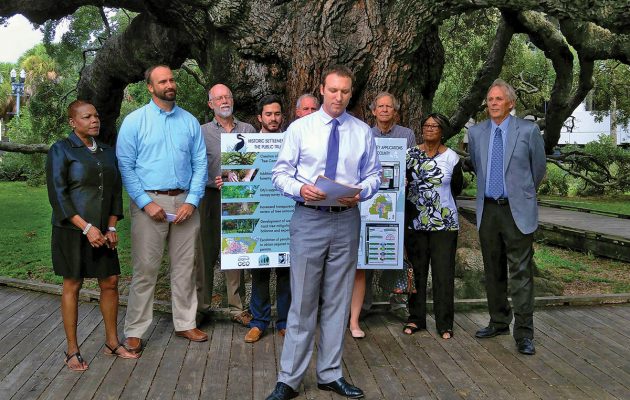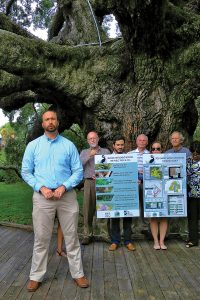City settlement over tree mitigation resolves issue, promotes beautification
Posted on August 2, 2017 By Editor Articles, Neighborhood News, Top Stories

In the welcome shade of the Treaty Oak on the Southbank, representatives of civic groups came together July 27 to celebrate the future of trees in Jacksonville and the July 25 resolution of a lawsuit against the city over the use of tree mitigation funds.
The suit filed in 2015 by the Public Trust Environmental Legal Institute of Florida challenged the city’s use of the Tree Mitigation Trust Fund – approximately $20 million – established in 2000 by charter amendment. Developers pay into the fund when they cut down trees and the money is supposed to be used to mitigate the loss by paying for new trees to be planted elsewhere in the county.
“There was no transparency about how much money was available in the fund,” said John November, Public Trust executive director. “The city failed to provide an accurate accounting.”
The settlement was the product of two years of discussions by November, Warren Anderson, Public Trust founder and chair, Lad Hawkins of Scenic Jacksonville, Tracey Arpen of City Beautiful Jax and Greenscape, Tom Larson of the Sierra Club, City Councilman John Crescimbeni, Chief Administrative Officer Sam Mousa, and several City of Jacksonville staff members.
“Sam Mousa was the chair of the settlement committee and accepted the challenge we brought,” Larson said. “The way he led the dialogue really helped us get more than we expected. From the beginning, we made it clear it was a friendly lawsuit. We wanted to bring attention to an area of opportunity that we felt was being neglected by the city.”
Anna Dooley, executive director of Greenscape, said she is confident the settlement will enable her tree advocacy group to plant another 300,000 trees around the city.
State Senator Audrey Gibson thanked the group for leading the fight. The Jacksonville Democrat was one of the original petitioners of the 2000 charter amendment that created the mitigation fund.
“Trees are the jewels of our landscape,” she said. “They are the finishing touches. They are so important to the quality of our air and water. They help deflect noise. They create spaces to help build community.”
The memory of the late attorney Bill Brinton, who died of cancer in June, was invoked repeatedly by speakers. Brinton was a tireless advocate for the beautification of Jacksonville and initiated the 2000 charter amendment.
“This was Bill Brinton’s baby,” Gibson said. “He had a way of pulling you in and keeping you in.”
“It’s hard to think of anyone who did more to make this happen,” Arpen said. “At least he knew about the settlement before he died.”
The settlement, which was approved by City Council last month, has several components:
- Tree Commission: The commission will be an advisory board, comprising a City Council member, the city planning director and five residents with some expertise in trees, three to be appointed by the council and two by the mayor. November expects the commission to be in place by Oct. 1, the start of the new City budget year.
- New city staff: The City also will hire an urban forest manager, who will oversee the urban forester and a new position, city arborist. The job of the arborist will be to plant trees and the urban forester’s job will be to do maintenance to keep the canopy healthy.
- Tougher penalties: The settlement also toughened the penalties for developers who don’t get permits to take out trees. It doesn’t apply to private homeowners.
“If you are a repeat offender, the costs will double and triple over time,” November said. “And now it’s not just the property owner who is liable but the contractor, too. That’s new.”
For instance, November said, if you remove 100 inches of trees (calculated by the diameter at Chest height), you pay $113 an inch for the permit. or $11,300. Without a permit, that same 100 inches could cost $22,600.
“We think it’s a major problem. For some people, it’s worth it sometimes to break the law and just pay the penalty but by closing this loophole we hope we will get them to pay it,” November said. “Major developers aren’t the problem. It’s the mom-and-pops. But we think we have put the pieces in place so we can track it and see who the violators are. If it’s unpermitted, we can file a complaint with the city and get a stop-work order and cite them.”
The new Tree Commission and city staffers will have at their disposal the data from a comprehensive tree canopy survey of Duval County being done this summer by Plan-it Geo, with a grant from the City’s Environmental Protection Board.
“It’s really more than a survey,” November said. “Plan-it Geo is doing a one-meter resolution map that will show where the plantable areas are.”
As trees are planted, the map can be updated to show the new projects. Overlays will give further details about wildlife corridors, heat islands, storm water and other data that will help with the planning process.
“People will be able to access the map and look at the canopy in their neighborhood. We want citizens to get engaged.”
Trees paid for with the mitigation fund must be planted on public property but citizens can suggest projects to their council members, he said.
The grant also included money for an education initiative directed at children.
“We’re going to be going around to schools and doing presentations to get kids excited about learning about the benefits of trees,” November said.
By Lilla Ross
Resident Community News




 (1 votes, average: 5.00 out of 5)
(1 votes, average: 5.00 out of 5)





